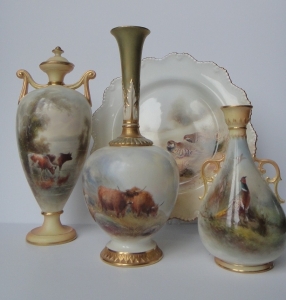12. European Pottery - Fall of Romans to the Present
| 1468 Page: 355 of 418 Go To Page: | ◁◁ First | ◁ Previous | Next ▷ | Last ▷▷ |
As with Wedgwood, generally in the 20th century the emphasis was on style and decoration, so individual painters signed their wares and became prominent. This led to a “cult” that included now-famous painters such as Edward Raby (flowers), Charles Baldwyn (birds – particularly swans), Richard Sebright (fruit), James, John and Harry Stinton (cattle especially highland), Harry Davis (sheep), Walter Sedgley (flowers), William Rickets (flowers), Albert Shuck (fruit) and William Powell (birds).
In the late 1940’s Royal Worcester developed hard paste porcelain for domestic use based on its laboratory ware body. This “oven to tableware” product was adapted to domestic freezers and ovens. It was championed by the TV cook, Fanny Cradock, and became a very popular and important product line for the company over the next 40 years. In the 1960’s there was such a demand for these cooking wares in the UK, Europe and even the Far East that a new factory was built to meet it. Although the original hard paste porcelain was made from China clay and Petuntse, other constituents can be used which combined produce the same chemical composition. Until production ceased, Worcester hard porcelain was made from China clay, feldspar and quartz.
The designs of Dorothy Doughty from 1934 to her death in 1962 were a new development in decorative porcelain for Royal Worcester, examples being the American Birds and the reproductions of natural flowers. They required advances in technology in preparation for firing, for example complex propping to prevent the models sagging when the porcelain became very soft at vitrification temperatures. Some models are very complicated, for example the Magnolia Warblers were put together using 80 moulds.
This compares with about 9 slip-cast moulds needed for a standard figure. Some birds required 5-600 handmade pieces with 30 different enamel colours and a significant number of kiln firings. Harry Davis assisted her in understanding the changes in colour of the enamels during firing. Dorothy and her sister Freda, who made figures of little children, made around 100 different figures, greatly helping the finances of the company.
Perhaps the most extreme examples are the Balinese and Siamese dancers, designed by Agnes Pinder-Davies, that were meant to be a limited edition of 25. However, after 20 years this number had still not been reached, as they were so difficult to assemble and fire without cracks or distortion.
In 1958 the holding company became Royal Worcester Ltd., and as mentioned earlier, in 1976 Spode came under common ownership within the Royal Worcester Group. Because of increased costs and competition in 2005 all production was outsourced, but by 2008 the Group went into Administration. In 2009 the name of the company was sold to the Portmeirion Group.





